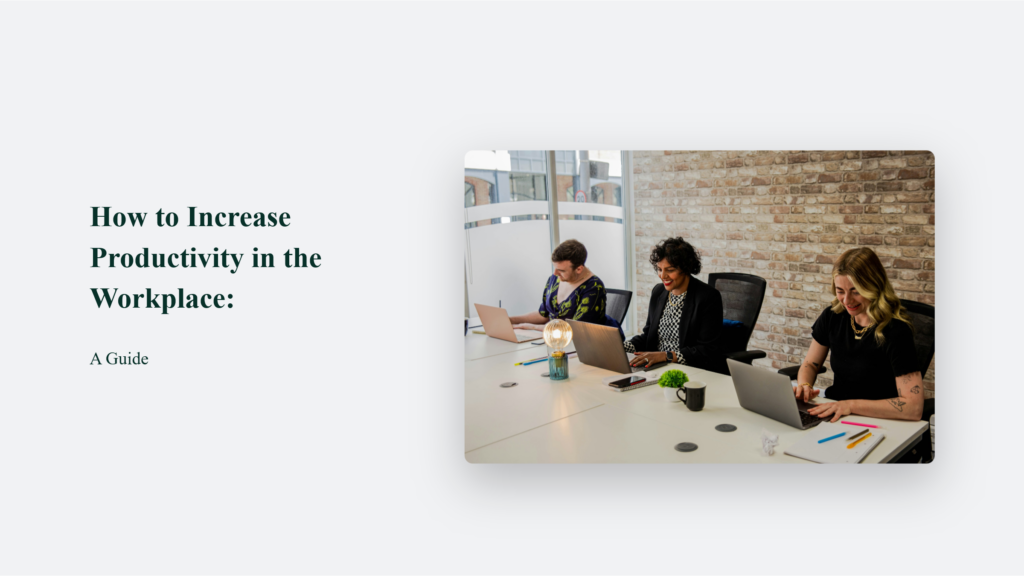

How to Increase Productivity in the Workplace: A Guide

As Seen On
Improving productivity is a constant pursuit for businesses to maximise efficiency and output. By implementing strategic approaches, organisations can cultivate an environment that empowers their workforce to work smarter, not just harder. This comprehensive guide explores proven methods on how to increase productivity in the workplace, without lost productivity and ultimately benefiting both the company and its employees.

Tips on How to Increase Productivity in the Workplace:
Establish Clear Goals and Priorities
The Eisenhower Matrix is a practical tool for enhancing workplace productivity by helping you prioritise tasks based on their urgency and importance. This method divides tasks into four quadrants:
- Urgent and Important (Do): These tasks require immediate attention due to their time sensitivity and importance. They include crises and other high-priority issues that could have significant consequences if not addressed promptly.
- Important but Not Urgent (Decide): Important tasks that do not require immediate action fall into this category. These tasks typically involve strategic planning or actions that contribute to long-term goals. You should schedule these tasks for later execution.
- Urgent but Not Important (Delegate): These tasks must be done soon but are less critical to your long-term objectives. Such tasks often include interruptions or minor requests that can be delegated to others.
- Not Urgent and Not Important (Delete): These tasks are neither urgent nor important and should be minimised or eliminated. They often include time-wasters or low-priority distractions that do not contribute to productivity.
To implement the Eisenhower Matrix effectively, start by listing all your tasks and categorising them into one of the four quadrants. It helps you focus on what’s truly urgent and important, prioritize tasks, delegate what you can, and eliminate what’s unnecessary. Using digital tools or templates can make this process more efficient by allowing you to visually organise and track your tasks.
Optimise the Work Environment
The physical workspace can significantly impact productivity levels. Ensure that your office layout promotes collaboration and minimises distractions. Incorporate ergonomic furniture, adequate lighting, and comfortable temperatures to further productivity apps create a conducive environment for focused work.
Additionally, encourage employees to personalise their workspaces with inspiring and motivating items. This sense of ownership can foster a positive mindset and increase overall job satisfaction, directly correlating with employee productivity.
Leverage Technology and Automation
In today’s digital age, embracing technology and automation can streamline processes and reduce time-consuming manual tasks. Invest in project management tools, communication platforms, and workflow automation software to simplify collaboration, time management method task tracking, and information sharing.
However, be mindful of potential technology overload. Provide training and support to ensure that employees can effectively utilise these tools without feeling overwhelmed by repetitive tasks or distracted by constant notifications and updates.
Encourage Breaks and Work-Life Balance
While it may seem counterintuitive, taking regular breaks can boost mental health and productivity. Encourage your team to step away from their desks to recharge and rejuvenate periodically. Suggest activities like short walks, stretching exercises, or mindfulness practices to help them reset and return to their tasks with renewed focus and energy.
Moreover, it promotes a healthy work-life balance by discouraging excessive overtime and encouraging employees to disconnect from work during their time. This approach can prevent burnout and foster a more sustainable level of productivity in good work life balance the long run.
Provide Continuous Training and Development
Investing in your employees’ professional development can yield significant productivity gains. Offer training programs, workshops, and mentorship opportunities that equip your team with the latest skills productivity tools, and knowledge relevant to their roles.
Encourage cross-training and job rotation to expose employees to different aspects of the business. It will broaden their perspectives and foster a more well-rounded understanding of different tasks of the organisation’s operations. It can also lead to increased engagement, creativity, and problem-solving abilities, contributing to higher productivity.
Recognise and Reward Achievements
Recognition and rewards are powerful motivators that can drive employee development and productivity. Implement a system that acknowledges and celebrates individual and team achievements through formal recognition programs, bonuses, or simple gestures of appreciation.
Celebrate milestones, successes, and exceptional performances to reinforce positive behaviours and foster a culture of excellence. It boosts employee wellbeing and morale and encourages employees to maintain high productivity levels and strive for continuous improvement.
Foster Collaboration and Communication
Effective collaboration and communication are essential for maintaining productivity and maximising productivity in the workplace. Creating opportunities for cross-functional collaboration and regular team meetings encourages open dialogue, knowledge sharing, and teamwork.
Implement communication tools and platforms that facilitate seamless information exchange. This will enable employees to stay connected and aligned with organisational goals and objectives. It can reduce redundancies, minimise miscommunications, improve productivity and foster a more cohesive and productive work environment.
Continuously Evaluate and Adapt
Productivity is an ongoing journey, and what works today may not be effective tomorrow. Regularly assess your team’s productivity strategies and gather employee feedback to identify improvement areas.
Encourage open communication and solicit suggestions from your team on how to streamline processes, eliminate bottlenecks maintaining workplace productivity, or introduce new productivity-boosting initiatives. Remain agile and adaptable, continuously refining your approach to align with your organisation’s and workforce’s evolving needs.
Conclusion
Increasing productivity in the workplace requires a multifaceted approach that addresses various aspects of the work environment, employee engagement, and organisational culture. By implementing the strategies outlined in this article, businesses can create a conducive environment that empowers their workforce to thrive, ultimately driving business success, and growth for the organisation.
Productivity is an ongoing journey; continuous evaluation and adaptation are key to sustaining long-term improvements increasing employee productivity. Embrace a continuous learning and improvement mindset, and foster a culture that values efficiency, collaboration, and employee well-being.
Konger
Up until working with Casey, we had only had poor to mediocre experiences outsourcing work to agencies. Casey & the team at CJ&CO are the exception to the rule.
Communication was beyond great, his understanding of our vision was phenomenal, and instead of needing babysitting like the other agencies we worked with, he was not only completely dependable but also gave us sound suggestions on how to get better results, at the risk of us not needing him for the initial job we requested (absolute gem).
This has truly been the first time we worked with someone outside of our business that quickly grasped our vision, and that I could completely forget about and would still deliver above expectations.
I honestly can't wait to work in many more projects together!
Disclaimer
*The information this blog provides is for general informational purposes only and is not intended as financial or professional advice. The information may not reflect current developments and may be changed or updated without notice. Any opinions expressed on this blog are the author’s own and do not necessarily reflect the views of the author’s employer or any other organization. You should not act or rely on any information contained in this blog without first seeking the advice of a professional. No representation or warranty, express or implied, is made as to the accuracy or completeness of the information contained in this blog. The author and affiliated parties assume no liability for any errors or omissions.

